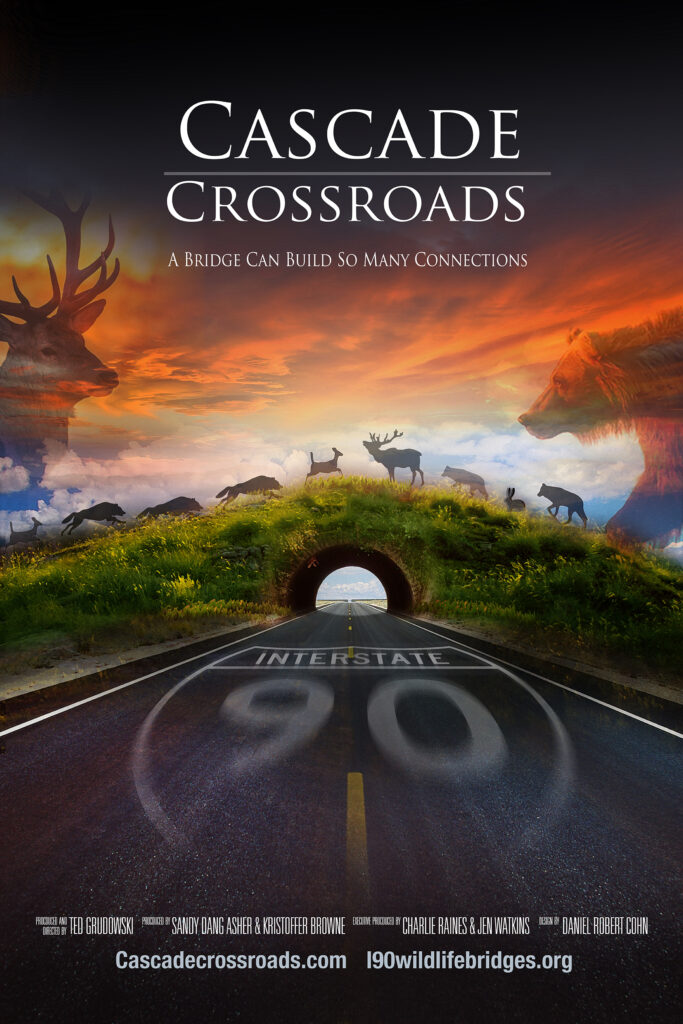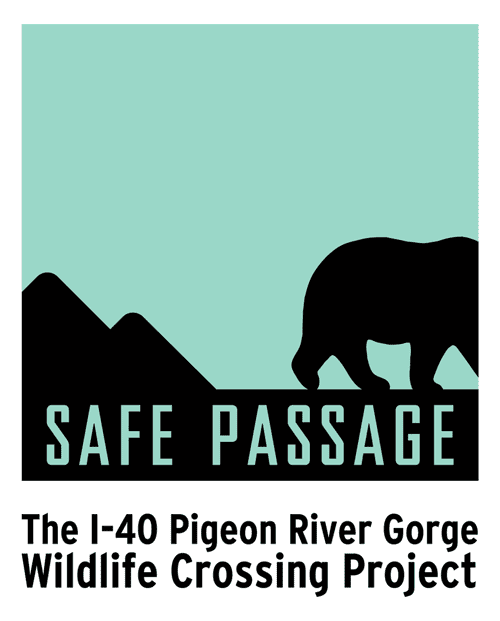By Frances Figart
Safe Passage is excited to host Ted Grudowski, whose films about road ecology in the Cascade Mountains of Washington State will be featured at The Crossing, a short-film screening coming to Asheville’s Pléb Urban Winery in the River Arts District on Thursday, October 26.
Released in January 2018, Cascade Crossroads is a 30-minute documentary film about building bridges, both literal and metaphorical. The setting is Interstate 90 just east of Snoqualmie Pass in Washington’s Cascade Mountains. This location is the intersection of a major east-west transportation corridor and a crucial north-south wildlife migration pathway. The film chronicles a monumental project combining conservation, collaboration, and innovation that eventually led to the construction of one of North America’s largest wildlife crossing projects in conjunction with major infrastructure improvements for motorists.
Cascades Crossroads won two Telly awards in 2018, gold in the nonprofit category and bronze in the nature/wildlife category. The follow-up film, Critter Crossings in the Cascades, was also well received. I asked Ted to tell us more about how he got into making movies that highlight the kind of change we want to see in the Pigeon River Gorge, East Tennessee and Western North Carolina, and throughout Southern Appalachia.

Q: How did you first become interested in and start a career in filmmaking?
A: It was partly a career path that was heading in that direction and partly stumbling into it. I studied photography while attending Southern Illinois University but after graduating the internet and digital media were beginning to rise. I went from photography, to multimedia, to creating short videos for an internet audience, but the lure of making something more substantial drew me to storytelling and making short documentary films.
Q: Do you recall any early experiences that made you aware of road ecology as an issue?
A: I didn’t learn about the current concept of road ecology until I began making videos about it, but I sure remember seeing a lot of roadkill on the sides of roads growing up in the Midwest. In the spring there were always dead skunks everywhere! It seemed that there were more dead than alive.
Q: The I-90 Snoqualmie Pass East Project and the related wildlife crossings and roadway improvements have been called a win-win for people and animals that offers a new model for major infrastructure projects bisecting wild places. How did you get involved with the I-90 project?
A: My first exposure to the project came through Conservation Northwest, a regional conservation nonprofit in the Pacific Northwest, who did a lot of public advocacy for the wildlife crossings as well as working to restore and acquire lands adjacent to the interstate. While the US Forest Service owned much of that land, there was still much of it owned by timber companies and other private landowners due to the legacy of checkerboard ownership from when railroads were being built across the western U.S. in the 19th century. The checkerboard legacy actually can be traced back to Abraham Lincoln!

I did a short video with my colleague Kris Browne around 2015 for Conservation Northwest highlighting their remote camera program in the forests of the Cascade Mountains in Washington. That program contributed to the realization that there was a major wildlife highway running north and south through the Cascades that was bisected by I-90. Shortly thereafter, the coalition of nonprofits and other groups was coming to an end because the decision to incorporate the wildlife passages into the highway improvements was already made and the first leg of funding secured. They wanted to document the story of how unlikely partnerships were made in order to get the passages and road improvements to happen, and so I was approached about making Cascade Crossroads.
Q: What was your process like working on Cascade Crossroads?
A: Our production team, which included Kris Browne and Sandy Asher in addition to me, had many years of storytelling experience stemming from our time working together on a small-business news series for MSN.com, as well as Kris and Sandy’s experience working on afternoon news programs on local Seattle television. They have a great knack for finding a concise story within a very big picture, and I loved taking the framework they made and adding the visual and audio elements to create something informative but that still makes you feel all the feels.
But when we started the film there was more than a dozen years of the story already in the past, so we relied heavily on media contributed by Washington State Department of Transportation, Washington Department of Fish and Wildlife, I-90 Wildlife Bridges Coalition and many more groups and individuals to tell the story. We were also very fortunate in having both Patty Garvey-Darda of the USFS and Brian White of WSDOT as our principal interviews because they are not only heroes in the story, but they are also very passionate, articulate, and great storytellers.
Q: Is there a particular moment when you saw the project was coming together and that felt like an “aha” moment for you?
A: When we made the first short video in 2015, I didn’t really grasp the depth and breadth of how incredible and unlikely it was to build the wildlife passages, as well as the implications of re-connecting the north and south Cascades with its animal highways and ecosystems. Initially we were eager for a chance to create a longer story than we usually had the opportunity to tell, but after we began doing the background research, we all realized that there was something much bigger here unfolding, and that was very exciting.
Q: How was it different doing the follow-up film, Critter Crossings in the Cascades?
A: Making Critter Crossings was very much like doing a victory lap in a sequel, because the successful results and improvements were already tangible, so it was a chance to show the world that this project was worth all the effort to make it happen. Cascade Crossroads had been very well received in film festivals and other public screenings, as well as winning some awards, so we knew that the public had an appetite for successful stories about helping wildlife. Plus, it gave us an opportunity to share the story and its success from the WSDOT perspective, because after all they were the ones who had to create the plan for building it all, turn that plan into reality and to demonstrate to the public that this was the right thing to do.
And, oh how right it was! How often do civil engineers get to be heroes? There have been literally thousands of animal crossings since the passages were completed and the guide fencing installed, with some unexpected animals using the passages—not just elk, deer, cougars, bears and endangered aquatic species, but a badger and a moose as well.
Q: Wildlife crossings have become a much bigger topic in the news since you made the first film. Why do you think that is, and where do you think the US is headed in the future in terms of road ecology?
A: People love animals, people love wildlife, and people love good news about people doing good things. It’s a counterpoint to all the bad news we are bombarded with about how people are doing things detrimental to our natural world, and everyone has seen dead animals by the roadside or even had a collision with an animal with their own car. The success of it all is quantifiable and undeniable. I hope it leads to a greater awareness of the natural world around us and our effect on it, and I hope it leads to accommodating wildlife becoming part of the vocabulary of all infrastructure in the United States.
Q: Cascade Crossroads aims to not only share the unique story of I-90 but also inspire action in other landscapes facing similar tensions between wildlife and roadways—like our Safe Passage project in the Pigeon River Gorge. Why are you excited about The Crossing and coming to Western North Carolina to be with the Safe Passage stakeholders for this event?
A: I’m very excited because I get to come bringing good news and encouragement for your wildlife passages. I love seeing road ecology ideas taking root on that side of the country, and I’m excited to see what success stories you will write. The excitement of your community to provide and care for your own wildlife is infectious!
